Best TV in Australia for 2024: the top screens for every budget
The best TVs you can buy in 2024, from great budget bargains through to premium OLEDs
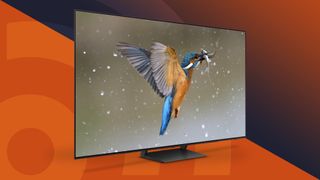
Searching for the best TV in Australia isn't easy, with constant improvement in TV screen technologies and jargon-filled features to get your head around. What is easy to understand, however, is that an excellent home cinema screen is more affordable than ever.
This guide to the best TVs in Australia will help you find the best option in your budget, based on our extensive testing experience with all the sets mentioned. Our picks include screens for all budgets and for specific use case scenarios.
also the varying factor of how bright (or dark) your room is. In Australia this is especially true, since we experience more sunshine throughout the year compared to our British and American cousins (a generalisation, of course). If you're looking for something specific, you might prefer to head straight to our guides to the best gaming TVs or even the best OLED TVs.
If you don't see a TV you have in mind on this list, bear in mind we may still have tested it, it's just that we think the TVs in this guide offer better value.
The quick list
Below you can find a roundup of our choices for the best TVs in Australia right now along with our summarised opinion. You can jump to a more detailed review of every pick, along with a price comparison tool to help ensure you find the best deals.
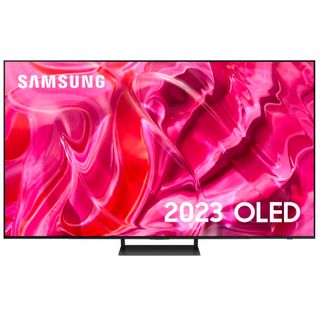
The best TV for most people
The Samsung S90C is the perfect all rounder. It serves up an excellent picture, is brilliant for gaming, and even has decent built-in sound. What's more, it provides a more budget way into the world of QD-OLED.

The best budget
Delivering a picture well beyond its price point, extensive gaming features and genuinely decent built-in sound, the C855 is a terrific bargain buy

The best mid-range TV
Proof that a great TV doesn't need to cost the earth, the Hisense U8N is a standout Mini-LED telly that belies its rather moderate price tag.

The best premium OLED TV
Samsung has continued to prove why it's one of the best TV makers, with the S95D serving up a detailed and vibrant image that benefits from glare beating anti-reflection tech.
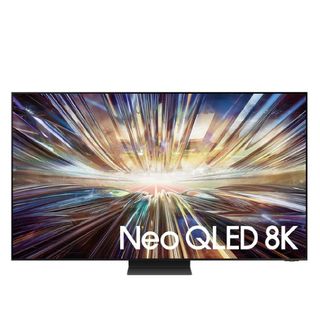
The best 8K TV
Improving upon its predecessor in ways we didn't think possible, the Samsung QN900D has a strong case for the title of best TV ever made...ever...so far
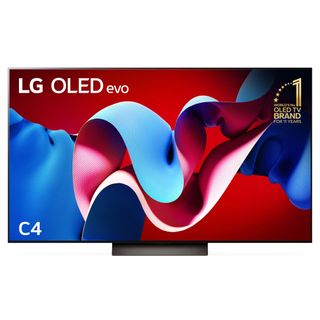
The best for versatility
Gaming, picture quality, an intuitive smart TV platform, and a wealth of sizes from 42-inch all the way up to 83-inches; the LG C4 ticks more boxes than most.
Load the next 3 products...
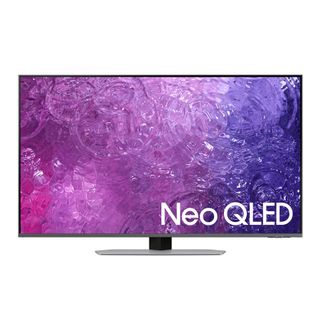
The best bright TV for daytime sports
Samsung's QN90C hits far higher brightness levels for watching on sunny days than almost any other set, making it ideal for sunlit Australian homes.

The best TV for sound
The Sony Bravia 8 delivers exceptional images, but it's the audio performance that wowed us. A vibrating screen coupled with dual subwoofers means you don't need to rush to add a soundbar.

The best TV for gaming
Support for the full suite of major gaming buzzwords, plus an incredible picture that is both bright and vibrant, makes the LG G4 an ideal games console companion.
Recent updates
September 26 2024
Replaced the Sony A80L with the Sony Bravia 8 as 'best TV for sound'
The best TVs in Australia 2024:
Why you can trust TechRadar
Below you'll find more in-depth reviews for each of the best TVs in Australia, along with links to the full reviews written by our TechRadar's team of TV experts.
The best TV for most people

1. Samsung S90C
Our expert review:
Specifications
Reasons to buy
Reasons to avoid
The Samsung S90C maintains the top spot on our best TV list because it does everything you could need from a TV, and does it well. Delivering a superb picture, gorgeous design and brilliant gaming performance, throw in access to QD-OLED technology for the cheapest it's ever been, and you have yourself a winning formula. With prices dropping over time too, this gives you real OLED bang for your buck.
With excellent contrast levels, dynamic and punchy colours and deep, rich blacks that we come to expect from an OLED, we found in our review that the S90C's extra brightness compared to the LG C3 or Sony A80L really does provide a more enjoyable viewing experience. And yet, all these TVs cost about the same amount of money, even with current discounts. Its sharpness levels and detail are also a sight to behold. One thing to note, though, is that the 83-inch model uses a regular OLED screen that's much less bright, so if you want to go supersize, we would recommend getting the 83-inch LG C3 (or C4) instead.
Not just a beautiful TV, the Samsung S90C is a fantastic option for gamers. It boasts a refresh rate of up to 144Hz to satisfy PC gamers, and four 2.1 HDMI ports that all support 4K 120Hz, VRR and ALLM for console fans. It also has a gaming hub so you can tweak settings easily to get the most out of your games. Add to this built-in sound quality that beats almost all other TVs, including LG's OLEDs, and you have yourself a complete package.
It's not totally perfect mind you. It's disappointing that Samsung still doesn't support Dolby Vision support, for starters, and we have to point out that the higher-priced OLEDs such as the Samsung S95C, the S95D (at #4 in this list) and LG G3 (and G4) can beat it for brightness. But in terms of what you get at this budget level, the Samsung S90C is real value for money and is the best TV for most people.
Read the full Samsung S90C review
The best budget TV

Specifications
Reasons to buy
Reasons to avoid
We expected the TCL C855 to take over as the best budget TV in Australia even before we published our review and, boy, were we right with our predictions. Improving upon the excellent C845 from 2023, the C855 delivers an outstandig all-around performance.
This time around you won't find a 55-inch screen size, with TCL seemingly believing we're all on a path to wanting bigger and bigger screens to grace our living rooms – if you have the space to fit the monstrous 98-inch variant, kudos to you. Where TCL has also gone big on numbers with the C855 is peak brightness. It claims 3,400 peak brightness, which is impressive, although we recorded a peak of 2,919 nits on a 10% window in Standard mode in our review. The full-screen nit count of 825 in Movie mode makes it ideal for watching in brighter daytime conditions, however.
TCL has also increased the controllable zone count significantly. The actual number will be dictated by the chosen screen size, with between 1,344 (65-inch) and 2,304 (85-inc) available. Interestingly, the 98-inch model gets fewer with 2,160 zones. The result no matter which screen size you opt for is improved contrast and colour accuracy – it actually beat the high-end Sony Bravia 9 in some of our tests.
We're also pleased to see the return of a generous selection of gaming features, including 144Hz support for PC gamers, AMD FreeSync Premium Pro, ALLM and Dolby Vision gaming.
Despite the updates and expected upgrades, TCL continues its penchant for affordable TVs, with prices starting at AU$2,999.
Read our full TCL C855 review
The best mid-range TV

3. Hisense U8N
Specifications
Reasons to buy
Reasons to avoid
The Hisense U8N is a sensational mini-LED TV that gives the flagships of the world a major run for their money. What impressed us most in our testing was how insanely bright the TV can go, especially for one in its price bracket. What's particularly impressive is how the Hisense U8N controls that brightness – its Cinema Day and Cinema Night picture modes are particularly great for 4K movies. Colours are accurate, too, although it must be said it's not the absolute best when it comes to upscaling HD content. It's not terrible by any means, but if you know you're going to want great upscaling, then you will need to look elsewhere and spend more.
The Hisense U8N is a great option for gamers too, although only two of its four HDMI 2.1 inputs support up to 4K/144Hz – the 144Hz is only relevant to PC gamers, but the same two ports also support 4K/120Hz for games consoles. One of the 2.1 ports is also used to connect to external sound devices via eARC, meaning you can only plug one console into the back of the U8N. It's not the end of the world, and Hisense is far from being the only TV manufacturer to do this, it's just something you should be aware of.
The TV's built-in 2.1.2-channel speaker system is good, but not great. If you don't own a soundbar or AVR, nor do you plan to invest in one, then you'll be able to enjoy content just fine. The speaker system can go loud and without distortion, and dialogue comes through clearly. Just don't get expect blockbuster levels of bass.
The best premium OLED

Specifications
Reasons to buy
Reasons to avoid
The Samsung S95D QD-OLED is what OLED TVs should strive to be. Improving upon what was already (and still is) an incredibly capable screen in the Samsung S95C OLED, the S95D serves up a gloriously detailed picture, helped hugely by the introduction of a anti-glare layer that means you can watch it without issue in bright rooms.
The S95D can go impressively bright – it's one of the brightest OLED TVs money can currently buy – delivering punchy yet natural colours and because of the OLED technology, blacks are inky deep.
Gaming is another area Samsung has continued to develop in the S95D, and once again you'll find four HDMI 2.1 ports, all of which support up to 4K 144Hz input and VRR, with additional support for AMD FreeSync Premium Pro. A built-in Gaming Hub with dedicated, easy-to-view settings, only adds to its gaming credentials.
And considering it's a piece of tech that you're going to be spending a lot of time looking at, looks are also important and fortunately, the Samsung S95D is drop dead gorgeous, with an attractive 'floating' design. It ain't cheap, but we think its suite of features more than justifies its price tag.
Read our full Samsung S95D review
The best 8K TV

Specifications
Reasons to buy
Reasons to avoid
Despite there still being very little in the way of 8K content, it hasn't stopped Samsung from continuing its investment in the technology. And with TVs like the QN900D being the fruit of that labour, we're not complaining one little bit. This is an exceptionally talented TV that is not only future proof, but can make 4K content look better than a dedicated 4K TV. Just be prepared to pay for it.
Key to the QN900D's success, and where it improves upon its QN900C predecessor, is the use of a new NQ8 AI Gen3 processor that ushers in much more neural processing power that gets to work upscaling content, as well as allowing the TV to better handle depth and motion.
The result is best-in-class picture quality with insane levels of brightness, but also incredible control of it to reveal fine details in images. Colours are rich and vibrant too, no matter the content. Motion handling is excellent, which will be a boon for those who love watching sports in particular. The only niggles we had with the display was that some screen glare was noticeable in brighter rooms and viewing angles can suffer a bit. Otherwise, it's practically faultless.
The built-in 6.2.4-channel speaker system is impressive for a slim TV, especially with its handling of Dolby Atmos soundtracks. If you really want to elevate your movie viewing experience then you will want to add a soundbar, but for casual viewing, there's a lot to like.
Read the full Samsung QN900D review
The best TV for versatility

Specifications
Reasons to buy
Reasons to avoid
The LG C4 is one of the best all-rounder TVs on the market, as it will comfortably slot into any home environment. Not only is the picture it delivers excellent, but it also offers every feature any hardcore gamer could possibly wish for, LG's easy-to-use webOS platform, and it comes in a wide range of sizes to suit all budgets and preferences.
Thank to its OLED technology, contrast levels are up there with the best. In fact, contrast has certainly improved compared to its C3 predecessor due to LG being able to eke out more brightness. What did surprise us a little more, however, was just how well the LG C4 fairs against reflections on the screen. Again, calling upon its brightness boost, it's able to better counteract any awkward light fixtures in your home.
As for gaming, the LG C4 serves as a fantastic option for those with next-gen consoles and even PCs. Stacked with features across four HDMI 2.1 ports including 4K, 144Hz support, VRR (including AMD FreeSync and Nvidia GSync) and its own useful Game Optimizer tool to name just a few, the C4 is sure to make gamers happy - and its 42-inch will suit PC gamers too.
It also arrives with webOS 24 as its smart TV platform, which is one of our favourites to use. It's simple to navigate (and easy to learn) and on the whole presents as a rather tidy option compared to some other TV OSes.
What keeps the LG C4 from the top spot is the fact it's bested in most areas by the Samsung S90C (which we expect will, itself, be bested by the S90D). The C4, also, can't confidently lay claim to havig best-in-class performance in any area. But, what it does do, it does very well.
Read the full LG C4 OLED review
The best TV for sport
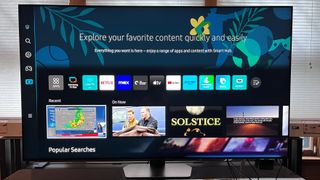
Specifications
Reasons to buy
Reasons to avoid
The QN90C is a 2023 mini-LED (or as Samsung calls it, Neo QLED) TV, which means that it offers higher screen brightness compared to OLEDs by places layers of extra-tiny LEDs behind its pixels. Coupled with an anti-glare screen to reduce light reflections to a minimum, it's our pick for daytime sport viewing, because in a bright room with sunlight streaming in, higher brightness means the images cut through any reflections, so you can actually see what's going on. In our review, we measured the peak brightness at over 1,700 nits – this is higher than any OLED TV we've ever tested, and is well over twice as bright as the LG C3, for comparison.
Not just for sports fans, the TV also comes with a whole host of gaming features including HDMI 2.1 across all four of its HDMI ports and a variety of cloud-based gaming features with support for Xbox, Nvidia GeForce Now and more.
Although not the most budget of options and lacking Dolby Vision support, the QN90C's fantastically bright picture certainly gives it the edge over other TVs in well lit rooms. And it's not just about that brightness – in our review, we were impressed with motion handling (which is great for sport), as well as detail and its deep black tones for movies.
Read our full Samsung QN90C review
The best TV for sound
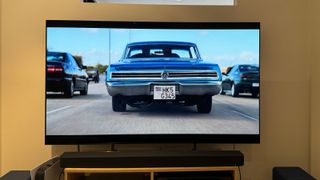
Specifications
Reasons to buy
Reasons to avoid
Sony's Bravia 8 OLED TV ushers in a fair few improvements over the excellent A80L, meaning it takes its predecessor's spot on this list. Once again, Sony has employed the use of its Acoustic Surface Audio+ technology that literally vibrates the screen to make sound with stunning results.
In our testing we found objects were placed accurately in the soundfield produced and because the sound comes from the screen itself, it is much more immersive than virtually all other TV sound systems. It does feature woofers for bass, but we must admit they don't offer the greatest impact, but we still conclude that if you come into ownership of the Bravia 8, there isn't the same essential need to add an external audio device as there is with other screens.
Sony has also made improvements to the picture, particularly where brightness is concerned. It's not a huge step up over its predecessor as it still uses a WOLED panel, but thanks to its new XR Processor, it is unmistakably brighter. The increase in brightness, combined with its gorgeous reproduction of colours, makes for sublime viewing.
As you might expect from Sony, the Bravia 8 has the PS5 front of mind and will automatically adjust picture settings when it detects one is connected via Auto HDR Tone Mapping. A dedicated Game Menu lets you quickly adjust further settings if you wish. It also benefits from two HDMI 2.1 inputs supporting 4K 120Hz video, variable refresh rates (VRR), and auto low latency mode.
While the Bravia 8 may not be our pick for the best, it nonetheless does more than enough to earn its place in the conversation about the top TVs money can buy and for those looking for a solid OLED at a price that won't entirely blow their budget, it might very well be a perfect fit.
Read the full Sony Bravia 8 review
The best TV for gaming
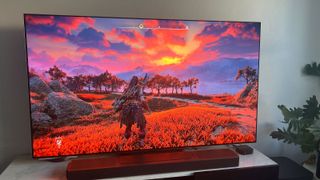
Specifications
Reasons to buy
Reasons to avoid
Its G3 OLED predecessor occupied this spot for some time, but the fact is the newer G4 OLED is now the outright best choice for anyone looking for a great gaming TV.
It's not cheap, but in the G4 OLED, LG has introduced a second-generation Micro Lens Array (MLA) panel which manages to eek out even more brightness, allowing for even greater contrast. And the resulting image is nothing short of spectacular. It doesn't go as bright as the QD-OLED panel found in the Samsung S95D, but that TV can't deliver the same deep black levels. You'll need to decide which screen option is best for you, but strictly in a gaming sense, the LG G4 is exemplary.
It supports all of the gaming features you could ever need, including Dolby Vision Gaming, VRR, ALLM, HGiG, AMD FreeSync and Nvidia G-Sync, along with 4K/120Hz support across all four of its HDMI inputs. There aren't many other screens that can lay claim to such a resume. LG's Game Optimizer dashboard is incredibly helpful, showing you current frame rates and offering up quick access changes to settings so you can fine tune the picture to your preference.
All this performance doesn't come cheap, but if you're able to get one, we know you won't be disappointed. Of course, not only is the LG G4 OLED a great gaming TV, but it's a dab hand with movies and TV shows too. Like it's slightly lesser-specced C4 OLED sibling, it's very versatile indeed.
What is the best TV?
For us, the best TV is the one that gives you the best overall value. We place particular attention on picture quality, sound quality, how easy it is to use and which connections it has, along with any other noteworthy extra features.
We've chosen the Samsung S90C as the best TV for most people because of its excellent levels of brightness that allow it to perform well in both bright rooms and dark rooms. This makes it a great option for ideal viewing both during the day and at night, meaning it's a great all-rounder.
Our reviewer also noted how good of a performer it is when it comes to gaming, and the fact that it offers many of the benefits of QD-OLED technology, without reaching the potentially unobtainable pricing of the S95C.
How to choose the best TV
When shopping for a new TV, there are as many things to consider as there are terms and abbreviations to try and get your head around. This can range from screen technologies (eg. OLED, QLED, Mini-LED, etc) to assets like HDR, VRR and Dolby Atmos, each of which are features worth considering when shopping for a TV but can be challenging to understand.
With this in mind, we’ve collected some of the key terms and technologies below to help you understand what they’re about and why they should matter to you:
Quantum Dot (QLED): QLED, which stands for quantum dot light-emitting diode, is a panel technology for TVs which sees a quantum dot filter layered over an LED panel to enhance visual quality. This quantum dot filter is a film of small crystal semiconductor particles which can be more precisely controlled to elevate the overall appearance of colours and contrast. When compared to the one-time norm of an LCD-LED screen, QLED overall offers superior brightness, colours and contrasts. Typically, QLED panels are also far brighter than OLED displays.
OLED: OLED, an abbreviation for Organic Light Emitting Diode, is a panel technology where each pixel emits its own light and therefore offers superior control for contrasts, colour and general picture. This differs from the LCD-LED displays that were once the norm which rely upon an external light source (backlighting). Similar to QLED, this allows OLED panels superior control when it comes to colours, contrast and overall picture quality to regular LCD-LED screens.
Read more on the differences between QLED and OLED TVs
Mini-LED: A more recent panel technology introduced to big-screen TVs, Mini-LED takes traditional LCD screens and drastically shrinks the size of the LED in the backlight behind it – oftentimes while including a quantum dot filter, too. Again, much like with QLED and OLED this allows for superior control of the backlighting, resulting in boosted colours and more accurate contrast. Mini-LED TVs may not quite match the perfect contrast levels seen in OLED TVs, but they do come reasonably close – all without the sacrifice to brightness or risk of burn-in.
Read more on the differences between Mini-LED and OLED TVs
High Dynamic Range (HDR): HDR is a technology which allows televisions to display a much wider spectrum of colours. Believe it or not, modern HDR televisions are able to display roughly 1.7 billion colours – a significant leap from Standard Dynamic Range (SDR), which is capable of a little under 17 million colours. HDR is therefore simply an indication that a TV boasts the ability to display clearer, more dynamic colours with more realistic transitions between shades, as well as deeper shadows which have the capacity to show more detail in the darkness.
The two most common HDR formats are either HDR10 or HDR10+, with HDR10+ considered to be the superior of the two as its name would suggest.The ‘10’ in the name refers to HDR’s 10-bit colour depth (SDR, by comparison, has an 8-bit colour depth).
HDR10+ is similar to Dolby Vision (see below), in that it uses dynamic metadata to adjust colours and brightness on a scene-by-scene basis. However it is available at an open standard which means content makers can take advantage of what it offers their content without having to pay the kinds of licensing fees they would with Dolby Vision.
Read more on HDR10+ and what it means for you
Dolby Vision: While Dolby Vision is similar to HDR10+ in a number of ways, it’s still considered a superior format, in that it can be mastered at up to 12-bit colour depth.
The latest update to Dolby Vision known as Dolby Vision IQ takes advantage of Dolby Vision’s existing picture and processing prowess while working with a light sensor to respond to various conditions that may otherwise impact the picture. This ranges from its ability to detect when you are watching in a particularly bright room and therefore adjust accordingly, to its ability to detect the different types of content you are engaging with on your TV such as movies, games, sports, etc.
Read more on Dolby Vision and what it means for you
What about gaming? If your primary concern while shopping for a new TV is what it can offer for gaming performance, various terms and features will emerge as relevant for you. To help you understand what these are, we have included a helpful guide in our list of the best gaming TVs to offer some assistance.
How we test the best TVs
The best TVs are chosen by our writers and editors based on a few main criteria: their overall picture performance including contrast, colour saturation and motion handling, as well as their feature set, design and the operating system they run on. We're looking for TVs that are well-built and have the technology to last for the next few years.
Obviously, there is some subjectivity that goes into the review process, however we strive to maintain fairness across brands by testing the same type of content on each screen (HD/SDR, 4K/HDR, games, movies and music) and reporting what we've found the experience to be like.
We test the brightness and colour range using a colorimeter, and we ensure that we test 'out-of-the-box' as well as after calibrating the screens ourselves, so that we can tell you what you'll get if you don't tweak at all, as well as what the TVs are capable of in the right hands.
Like our readers, our writer's and editor's room layouts differ and may cause slight disparities in testing, however we make every attempt to question our assumptions and troubleshoot our issues with performance in every review.
FAQs
Which TV has the best picture quality?
On performance alone, OLED TVs typically have the edge on picture quality, offering deep blacks and stunning contrast, confident colours and improved viewing angles over other panel types. For brightness, Mini-LED appears to have the current edge, offering eye-scorching images without the risk of burn-in.
Beyond panel technology, TVs offering one or (even better) both HDR10+ and Dolby Vision will also offer superior value to picture quality potential than TVs which don’t support these formats.
Which size TV is best for home?
There really isn’t any ‘one size fits all’ when it comes to TVs – the answer really depends on your home, how you hope to use your TV, and other factors like how many people will be watching.
For the best viewing experience, any TV that’s 55-inches or above will get the job done, with anything larger than 77-inches potentially being overkill unless you have a large family and a big space to put it in. Smaller TVs don’t necessarily sacrifice on quality even if they do on size, and our list of the best 48- and 50-inch TVs can help you pick the right one for you.
Next steps
- Want better audio? Check out our guide to the best soundbars available.
- Once you've decided on a panel, make sure you read our guide on how to set up your TV to make sure you're getting the most out of it.
- Are you looking for the best universal remote for your new home theater setup?
- Need something to watch on your new TV? check out our list of best TV streaming services.
Get daily insight, inspiration and deals in your inbox
Sign up for breaking news, reviews, opinion, top tech deals, and more.
Max is a senior staff writer for TechRadar who covers home entertainment and audio first, NBN second and virtually anything else that falls under the consumer electronics umbrella third. He's also a bit of an ecommerce fiend, particularly when it comes to finding the latest coupon codes for a variety of publication. He has written for TechRadar's sister publication What Hi-Fi? as well as Pocket-lint, and he's also a regular contributor to Australian Hi-Fi and Audio Esoterica. Max also dabbled in the men's lifestyle publication space, but is now firmly rooted in his first passion of technology.
- James CutlerStaff Writer
